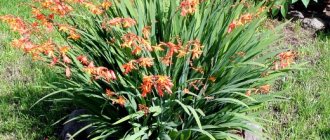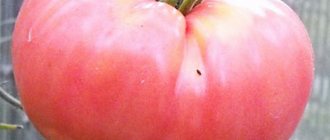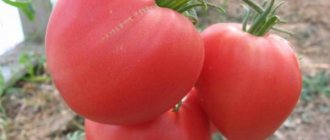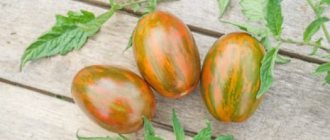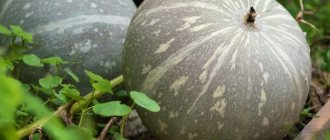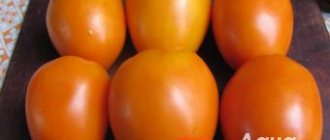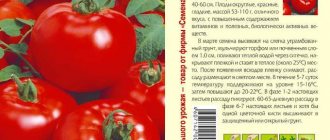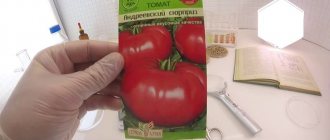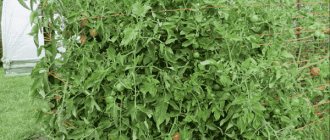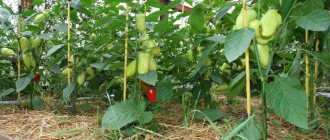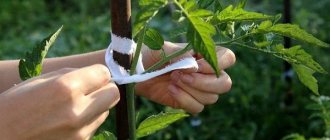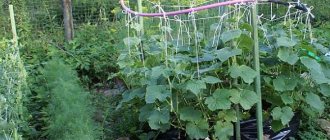» Vegetable growing » Tomatoes » Varietal characteristics of the Major tomato
0
1182
Article rating
Tomato Major is a hybrid variety. Scientists specially developed it to combine high growth rates and high yields. Contrary to popular belief that hybrid tomatoes are bland, these tomatoes will delight you with their rich aroma, juiciness and sweet-sour taste. It will be a great addition to any dish.
- Advantages and disadvantages of the variety
- Growing
- Seedling
- Transplantation into the ground
- Care
- Errors during cultivation
- Disease and pest control
- Reviews from gardeners
Varietal characteristics of tomato Major
Brief information about the variety
- Fruits and bush : red tomatoes, weight – 150-300 g; The bush is standard, indeterminate, reaches 180 cm in height.
- Productivity : 4.5 kg per bush.
- Resistance : low frost resistance, immunity to late blight.
- Distribution : southern regions of Russia and areas with a temperate climate (planting in open ground is possible); in the north of the country, tomatoes should be planted in a greenhouse.
- Application : salads, canning, freezing, ketchups and pastes.
- Planting : seedling method. Transplantation - towards the end of May. For 1 m² – 3-4 bushes.
- Soil : light and turfy.
- Care : fertilizing and watering - once every 20 days, pinching - optional, does not require formation.
- Ripening period : the harvest ripens in early to mid-July, the plant bears fruit until the end of September. Tomatoes are suitable for long-term storage.
Tomato 'Zhenaros F1'
Main genus: Tomato
| Productivity |
| Ripening period |
| Soil type |
| Growing method |
| Purpose of fruits |
| Disease resistance |
| Soil ph requirements |
| Life form |
| Shape of fruits/stems/roots and tubers/heads |
| Size of fruits/stems/roots and tubers/heads |
| Cultivation region by origin |
| Vitamin content |
| Color of fruits/roots and tubers |
| Peel thickness |
| Frost resistance |
| Drought resistance |
| Decorative value |
| Taste of fruits |
| Shelter for the winter |
| Pest resistance |
| Habit |
| Keeping quality |
| Parthenocarpic |
| Branching pattern |
| Density and character of the pulp |
Expand all properties
Description of the plant:
Tomato 'Zhenaros F1' is a hybrid selection of the Dutch company DE RUITER ZODEN. Approved for use in the 3rd light zone in 1998.
Recommended for extended and summer-autumn rotations. Valued for its high commercial quality and fruit set, as well as resistance to extreme growing conditions.
Dimensions and growth form:
The hybrid 'Zhenaros F1' is represented by indeterminate, open-type, medium-sized plants. The foliage and branching are moderate, the internodes are average. The leaf is ordinary, not very large, yellow-green, slightly corrugated.
The inflorescence is simple, the structure is intermediate, there is no hall. The first inflorescence is laid above the 9th leaf, the subsequent ones - after 3 leaves.
Fruit:
Size, shape and color:
The fruit is dense, flat-round or round, weighing 114–154 g. The surface is slightly ribbed, glossy. The base is level, the top is smooth. The color of the unripe fruit is green with a small dark spot, the ripe one is red. Number of nests 5–6.
The taste of the fruit is good to excellent.
Ripening time and yield:
Tomato 'Zhenaros F1' is a mid-early hybrid. Fruit ripening occurs on the 100–124th day after full germination. The yield is high and amounts to 21.3 kg/m2 in extended rotation.
Disease resistance:
The hybrid is resistant to tobacco mosaic virus, cladosporiosis, fusarium, late blight, verticillium and root-knot nematode.
Characteristic
Tomato Major F1 is a relatively new variety. But nevertheless, he has already managed to gain popularity in Russia.
Description of fruits and bush
The fruits of the Major variety are heavy - from 150 to 300 g. They have a bright red skin. They are smooth, round, slightly flattened. The skin is glossy and prone to cracking.
When cut, the tomato is very juicy and fleshy. The taste is sweet and sour.
The bushes are spreading and tall. Their growth is not limited (indeterminate variety). On average, they reach 180 cm. The stems are thin, so the plant needs timely garter. It is also recommended to remove stepsons. The leaves are dense, which increases the load on the stem. That is why they also need to be trimmed.
Productivity and fruiting
Major tomatoes have good yields. From 1 m² up to 7 kg of tomatoes are harvested.
The variety bears fruit 60 days after planting the seedlings in open ground or a greenhouse. The better the conditions for the growth of tomatoes, the faster the desired result can be achieved.
This is an early ripening variety. In greenhouse conditions it gives a quick harvest.
Resistance to diseases and pests
According to the description, this tomato is resistant to rot. It is also not affected by powdery mildew.
Important! When growing in a greenhouse, you should be careful: there is a possibility of excess moisture.
Insects do not attack this plant.
Area of application of fruits
The fruits have excellent taste
The sweet and sour taste of the fruit is ideal for salads. Therefore, immediately after harvesting, tomatoes are consumed fresh.
But at the same time, the Major tomato variety is suitable for canning. In addition, it is used to create sauces or pastes.
This is one of the few types of tomatoes from which tomato juice is made. The taste is interesting and pleasant; there is no need to add sugar.
Growing regions
This plant is quite heat-loving. Therefore, it is better to grow it in greenhouses. In central Russia and the northern regions, planting in open ground is unacceptable, because these conditions are unsuitable for tomato.
In the south of the country, the variety can be planted in open ground, but only at the end of May, when the air and ground temperatures are close to summer levels.
():
In the south of the country, tomato seedlings are planted in the ground at the end of April, because... At this time the weather is already quite summer with a temperature of +20-25 degrees.
Farmer reviews
Favorable reviews from those who planted the hybrid do not allow us to doubt the reliability of the vegetable crop. Here are the opinions of gardeners:
Valentina, Orel: “I plant the hybrid in a greenhouse for two seasons. I formed the bush with two stems and tried it with three stems. The yield is stable, the tomatoes are tasty. Excellent for salads and pickles.”
Evgeniy, Krasnodar region: “Weather conditions allow us to grow tomatoes in the garden. The fruits of the first harvest are large. We use them for salad. Further, the ovary becomes smaller, but for preservation it is just right. This is not the first time I’ve planted a hybrid and I will plant it again.”
Advantages and disadvantages of the variety
The characteristics of the variety include the following advantages of the Major tomato:
- sweet and sour interesting taste;
- good yield;
- versatility of fruit use.
The disadvantage of tomatoes is the need to grow them in greenhouse conditions. This is not always possible.
():
For this purpose, there is varietal zoning, according to which in certain zones of the country their own varieties of vegetables (including tomatoes) and fruits are recommended for growing.
Growing
Tomatoes are grown in compliance with certain rules. Major is a heat-loving plant, which means that even at home some requirements must be met.
Seedling
When growing seedlings, you need to pay attention to air temperature. It is important that the room is warm enough. Cultivating seedlings is a serious step on the path to obtaining a good harvest. You must follow the rules on the seed package.
The first step is to purchase good seed material. It should be purchased from trusted suppliers. Seeds must be in sealed packaging.
Open the packet and place the seeds on gauze. Make sure they are not deformed or rotten. Major F1 tomato seeds should be pre-disinfected. To do this, gauze with them is placed in a container with a weak solution of potassium permanganate.
At this time, you can start preparing the soil. It is recommended to place the seeds in soil intended for growing vegetables. It is purchased in specialized stores.
But soil from the land can also be used. True, it must first be cleaned.
- First, remove all roots, insects, debris and other foreign objects from the ground.
- Then spread the soil over a baking sheet and place in the oven preheated to 60° for 2 hours.
- Cool the soil.
Choose a standard seedling box – elongated and not too wide. The most important thing is that it has holes to drain excess moisture. Her variety Major F1 is not very popular.
- Place the soil in boxes and water it well.
- Then make several holes and place the seeds in them.
- Level the ground and water it thoroughly.
If it is quite cold outside and the temperature in the apartment is below 21 °C, then it is better to place the plant under film and place it on a window on the sunny side. If this indicator is above 22 °C, then you can not use the film and simply take the seedlings to the window.
It should be watered as the top layer of soil dries. Try not to flood the plant.
():
The seedlings are ready to be transplanted to a permanent place at the age of 40-50 days. By this time, it should have formed a strong stem at least 15-18 cm high and 4-5 true leaves. Overgrown seedlings take root poorly and lose running time.
How to grow tomatoes
After 2 months, the seedlings are ready to be transplanted into the ground. By this time, the bushes have at least 5-6 true leaves, and the plant has a developed root system. Transplantation into open ground is carried out 2 weeks later than in a greenhouse.
Landing
Before transplanting, tomato beds are treated with a hot mixture of copper sulfate and mineral fertilizers are applied. A little ash is added to the bottom of holes 20 cm deep and filled with water.
What are the benefits and harms of aspirin for the human body?
Replant on a cloudy day or after sunset. The tomato does not like direct sunlight, it will be more difficult for it to take root.
Planting pattern: 30 cm – distance between seedlings, 40 cm – between rows. For 1 sq. m place no more than 8 plants.
Further care for tomato Major f1
As young bushes adapt to new conditions, regular watering is established no more than 2 times a week. Do not forget that in rainy times the amount of watering should be reduced, and on hot and dry days, on the contrary, increased. Water at the root with warm, settled water, without flooding the beds.
Reference ! Overmoistening of the soil provokes the development of fungal diseases.
After each watering, the soil is loosened and hilled up. These techniques not only promote better penetration of oxygen to the root system, but also become necessary preventive measures in the fight against many pests.
Fertilizing is done three times per season: during flowering, during the formation of ovaries and during fruiting. Feed with a full complex of mineral fertilizers or organic matter. The culture responds well to the addition of mullein infusion in a ratio of 1:10.
During fruiting, potassium fertilizers are added to the fertilizing for faster fruit filling.
Reference ! All fertilizing is applied after watering.
Features of care and possible difficulties
Tall bushes require obligatory staking not only of the stem, but also of the fruit-bearing branches. The branches are spreading; when the fruits ripen, they cannot withstand the weight of their weight and bend down to the ground. When contacting wet beds, the fruit begins to rot.
To secure the plants to the support, wooden stakes or metal rods are installed next to each bush, to which the plants are tied as needed.
Many shoots form on the bushes from an early age, which must be removed, otherwise unnecessary shoots will consume a large amount of useful substances.
When forming a bush with 2 stems, the maximum yield is obtained, but the resulting fruits have less weight . Nevertheless, entrepreneurs grow crops in this way for the greatest quantitative return.
Diseases and pests
The tomato variety Major f1 is immune to dangerous diseases of the nightshade family, such as blossom end and root rot, powdery mildew. However, the risk of infection with cladosporiosis (brown spot) remains. Cladosporiosis is a fungal disease that mainly affects greenhouse plants. It is characterized by the appearance of yellowish spots on the leaves, which subsequently dry out and crumble.
Prevention of fungal diseases means moderate watering, loosening the soil and removing weeds with roots . The main thing is to prevent the soil from becoming waterlogged.
In greenhouse conditions, along with elevated air temperatures, ideal conditions arise for the development of fungal infections. The pathogenic environment is destroyed by a regular influx of fresh air, so closed structures are systematically ventilated, avoiding drafts.
In case of infection, broad-spectrum fungicides “Bravo” or “HOM” are used. Traditional methods use iodine with milk, dissolving 15 drops of iodine in 0.5 liters of milk. Then the resulting mixture is added to 5 liters of warm water and the resulting solution is sprayed on diseased bushes once every 2-3 days.
Dangerous insect pests include whiteflies, Colorado potato beetles, and aphids. For whiteflies and aphids, a soap-ash solution is used to treat the stems and branches of plants. The Colorado potato beetle is controlled with the drug “Prestige”.
Transplantation into the ground
Tomatoes need sunlight
It is recommended to transplant tomatoes into the ground towards the end of May, when the soil temperature exceeds 15 °C.
In the southern regions, this procedure can be done earlier. In the northern regions, transplantation into a greenhouse is allowed.
- Before transplanting your seedlings, make sure they receive enough fertilizer.
- Water the plants well the day before the procedure.
- Check the weather forecast. It is important that no precipitation is expected in the first week after transplantation.
- Transfer plants into the ground very carefully so as not to damage their roots.
Place 3-4 bushes per 1 m². Remember that they grow quickly. It’s great if you choose a well-lit place.
As soon as the tomato is in the ground, it needs to be watered well.
Care
Ground tomatoes, like seedlings, need timely watering. This must be done every time the top layer of soil becomes dry. Watering is carried out on average once every 3 days. It should be quite plentiful.
():
Such frequent watering is carried out if the air temperature is about +30 degrees. The rest of the time, it is enough to water the tomatoes once a week, spending 5-7 liters of water per bush.
Since the bushes are spreading, they need more moisture. Therefore, gardeners advise installing a drip irrigation system for such varieties.
Also do not forget about mineral supplements. Apply it approximately once every 2 weeks.
Transplanting
The appearance of the first leaves is a signal about the beginning of the dive. During this procedure, the sprouts are transplanted into separate containers, complex fertilizers are added for growth and irrigated with water. Next, the hardening process is very important; for this, several weeks before planting, the seedlings are taken out into the air, initially for half an hour, and then for the whole day. After planting in open ground, the bush at the growth stage must be formed into two stems; this procedure is done by pruning.
Fertilizers
The “Major” variety takes well to all kinds of fertilizing, especially those containing potassium and phosphorus. During planting, it is good if the vegetable grower treats the holes with wood ash or superphosphate. When the period of active fruiting begins, it is better to apply organic fertilizers; they do not affect the taste characteristics.
Watering
Another important point in growing this variety will be watering. Vegetable growers living in the southern region need to take control of this process, because this zone most often suffers from droughts. Therefore, initially after planting it is recommended to water 1 or 2 times a week; as the plant grows, the number of waterings increases.
Errors during cultivation
Gardeners make typical mistakes when growing the Major tomato variety, but they can lead to negative consequences.
- Too dense placement in the garden bed. The bushes grow very quickly and require a lot of space. If tomatoes are planted next to each other, they will lack moisture and nutrients. In addition, they will shade each other.
- Watering too often. Although the plants are not susceptible to rot, this bug can cause the fruits and leaves to become limp. As a result, you will get tomatoes that are not the most pleasant to taste.
- No garter. Many gardeners think that the bushes will not break under the weight of tomatoes. This is wrong. If the stem breaks, the flow of nutrients to the upper part of the bush, where there are also fruits, will be disrupted. This threatens crop loss.
Disease and pest control
If pests have settled on a Major F1 tomato bush, it is necessary to treat it urgently.
Gardeners advise spraying the plant with a solution of copper sulfate. Do this 2 weeks before harvest. Also, if the crop is affected by any disease, you need to purchase a special mineral fertilizer in the store.
():
Copper sulfate is a fungicide. It is used to combat fungal diseases. To destroy pests, insecticide preparations are used, for example Decis, Regent, Confidor.
Tomato Major F1. SeDeK
SeDek "Determinate tomatoes." Tip of the day.
Low-growing tomatoes for open ground
